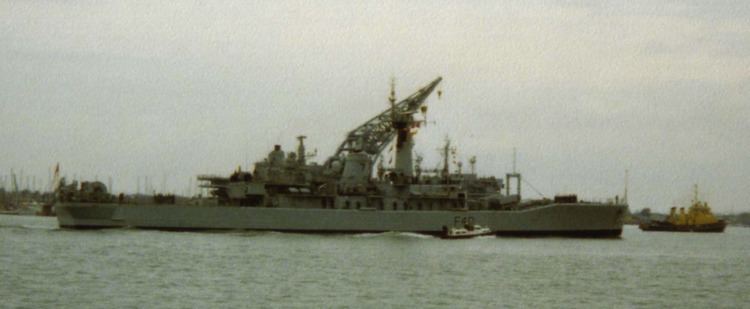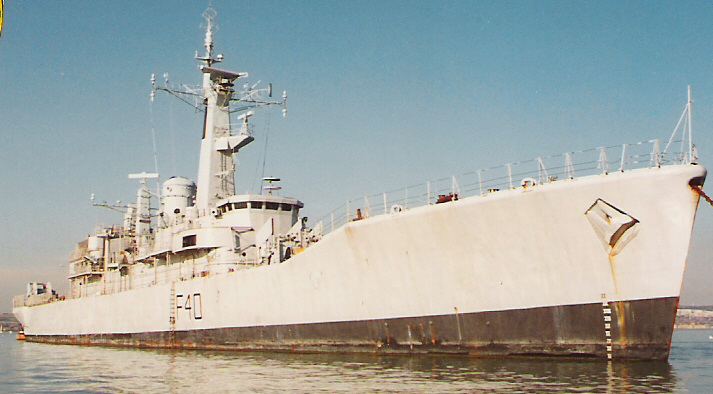Name HMS Sirius Commissioned 15 June 1966 Identification F40 Launched 22 September 1964 Builder HMNB Portsmouth | Laid down 9 August 1963 Decommissioned 27 February 1993 Construction started 9 August 1963 Length 113 m | |
 | ||
Motto Heaven's light our guide | ||
HMS Sirius (F40) was a Leander-class frigate of the Royal Navy (RN) built by H.M. Dockyard Portsmouth, and was the penultimate RN warship to be built there for a period of forty years, until Vosper Thorneycroft built HMS Clyde. Sirius was launched on 22 September 1964 and commissioned on 15 June 1966.
Contents

Operational history

Shortly after commissioning Sirius was present at Portsmouth Navy Days. In January 1967 she undertook a Beira Patrol, which was designed to prevent oil reaching landlocked Rhodesia via the then Portuguese colony of Mozambique. Sirius subsequently deployed to the Far East and Pacific, which included a number of 'fly-the-flag' visits to a variety of ports. Sirius also took part in the Coronation of Taufa'ahau Tupou IV of Tonga. The following year, Sirius deployed to the West Indies.In 1968 she took part in Portsmouth 'Navy Days'.

In 1970, Sirius again deployed to the West Indies, where she would perform the role of guard ship in that region. The West Indies Guardship deployment was eventually replaced by the Atlantic Patrol Task. While in the West Indies, Sirius assisted during the St. Kitts disaster, when a ferry sank, killing around 250 people. Sirius helped rescue 100 people from that vessel. For the actions of her crew, Sirius was awarded the Wilkinson Sword of Peace. In 1973, Sirius became guard ship to the West Indies once more, performing a variety of duties while there, including counter-drug operations.

In 1974, Sirius joined Standing Naval Force Atlantic (STANAVFORLANT), a multi-national squadron of NATO, taking part in naval exercises in the process and visiting a variety of ports, and one of many deployments with NATO's multi-national squadrons. In 1975, Sirius began her modernisation which included the removal of her single 4.5-in twin gun in favour of the Exocet anti-ship missile system, as well as the amount of Sea Cat missiles she carried, increased. The modernisation was completed in October 1977. In 1978, Sirius became the leader of the 6th Frigate Squadron.
In September 1982, Sirius deployed to the Falkland Islands to perform a Falkland Islands patrol in the tense aftermath of the Falklands War. The following year, Sirius received the towed array sensor. In 1988, Sirius, as part of the group deployment Exercise 'Outback 88', deployed to the Far East and Pacific, attended Exercise Starfish with New Zealand, Australian, Malaysian and Singaporean naval units, and visited Australia for the 1988 bicentennial naval Salute, visiting a variety of ports in the process.
On 27 February 1993, Sirius decommissioned. She was subsequently towed to Pembroke Dockyard in preparation for her to be sunk as a target. However, her sinking was delayed by environmentalist groups. In 1998, Sirius was finally sunk as a target in the Atlantic Ocean by the submarine Spartan. Her sinking left just one Leander, Scylla, afloat in the United Kingdom; Scylla was later sunk as an artificial reef on 27 March 2004.
